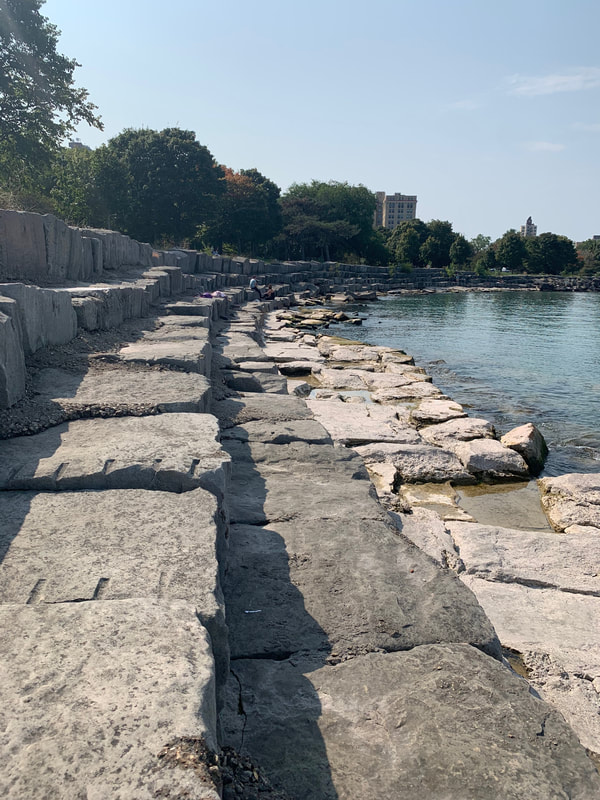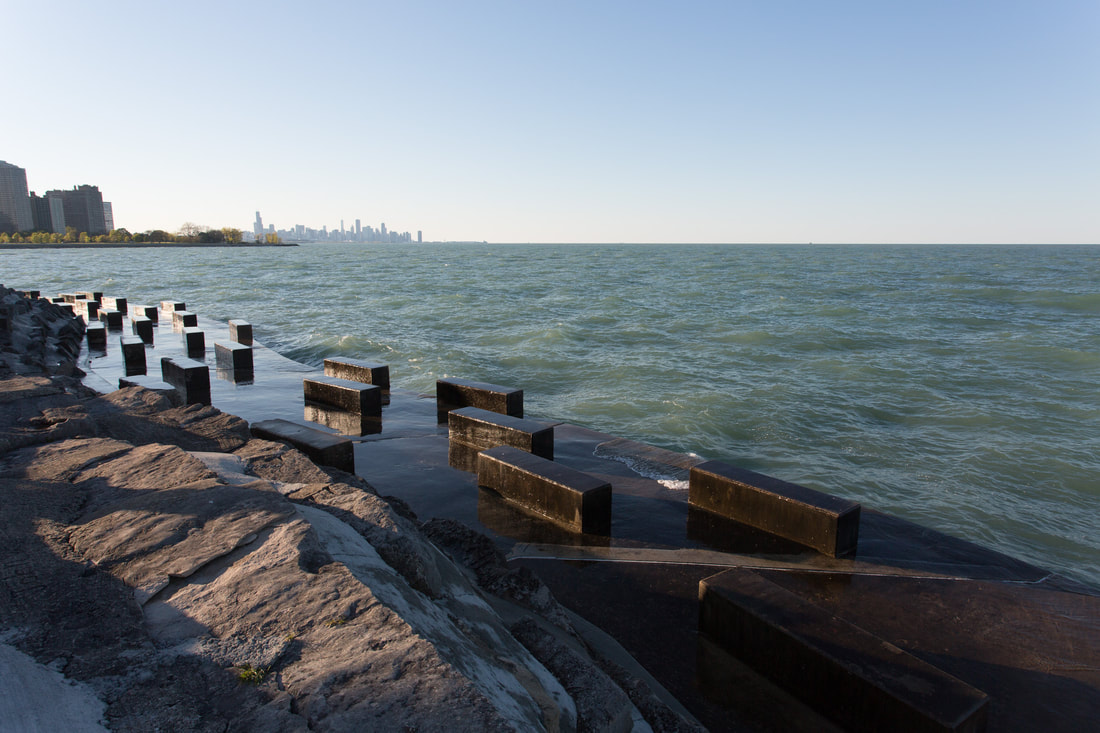|
The Richard H. Driehaus Foundation has awarded Promontory Point Conservancy a generous grant to complete our coastal engineering design study. Earlier this month, the Conservancy also won two grants from the National Trust for Historic Preservation and Landmarks Illinois for an historic treatments consultant to work with McLaren and ensure preservation standards are met in the design plan. We are highly delighted and greatly honored by these awards!
The Driehaus built-environment grant allows us to resume work with our coastal engineers McLaren Engineering Group and to complete the Alternatives Design Study and Cost-Benefit Analysis for Promontory Point. Watch for the release of this study this fall and for the community meetings we will be holding: we will be gathering your input and feedback for refinement of the Community’s Legitimate Preservation Plan for the Point. Our plan is the only plan, to date, that combines storm damage and shoreline protection, preservation of the historic limestone and ADA accessibility. The grants from the National Trust and Landmarks Illinois allow us to hire an historic treatments consultant to complete an Historic Structures Report, the first in the 24-year history of the struggle to Save the Point, as required by federal regulations, to advise and assist McLaren so that its design plans comply with preservation standards and to coach the Conservancy through the federally mandated Section 106 Review which the Chicago Division of the U.S. Army Corps could begin as soon as next spring. Construction at Promontory Point will most likely begin spring 2026. Our gratitude to The Richard H. Driehaus Foundation, the National Trust for Historic Preservation and Landmarks Illinois for their support and generosity. And thank you, all, for your ongoing support of our work to protect and preserve Promontory Point and the community that gathers there.
0 Comments
Parks and beaches as nature-based solutions to lakefront erosion and climate change challenges7/28/2023 Friends of the Parks presents this outstanding lecture on nature-based solutions to lakefront erosion and climate change challenges as part of their Netsch lecture series.
This afternoon the Commission on Chicago Landmarks cast its final vote to make Promontory Point a Chicago Landmark. It was unanimous!
Many spoke in favor including the Conservancy's Jack Spicer, Alderman Leslie Hairston, Ward Miller and Mary Lu Seidel of Preservation Chicago, and Kendra Parzen of Landmarks Illinois. Journalist Alison Cuddy summed it up well: "Congratulations!!! The warmth and enthusiasm of the Commission, Leslie Hairston's smile and [DPD Commissioner] Maurice Cox's comments about feeling proud to be 'witnessing history' -- what a wonderful, joyful moment." The ordinance declaring the Point a Chicago landmark will be introduced to the City Council at its March 15 meeting. From there, the ordinance will be reviewed by the Committee on Zoning, Landmarks and Building Standards before it comes back to the full City Council for a vote. If all proceeds smoothly, the ordinance to declare Promontory Point a Chicago landmark may be voted on at a live City Council meeting on April 19, 10:00am. Join us and attend -- in person or live stream -- this historic vote for the Point. Witness history! Most importantly, the stage is now set for the City (CDOT), the Chicago Park District and the U.S. Army Corps to work openly with the community to fix the historic limestone revetment at the Point instead of destroying it. There is now a shared, common preservation language, precisely the Secretary of the Interior Standards for the Treatment of Historic Properties, for a common, shared plan for fixing the historic limestone revetment:
Truly a beautiful day in the neighborhood! After receiving 350 letters from Point lovers (YOU!), The Chicago Park District's Board of Commissioners unanimously voted to approve Chicago landmark protections for Promontory Point! As the property owner, the Park District was not required but was requested to give its permission for Promontory Point to move forward in the landmarking process. The vote today means that the Point is ever closer to becoming a Chicago City-landmark!
In a statement to the press, Promontory Point Conservancy President Jack Spicer said, "This is a tremendous moment for the community and for Alderman Hairston who have been fighting side by side for 23 years to protect and preserve the unique and historic limestone revetment at Promontory Point. We are now one step closer. From here on out, we need to be sure that the Chicago Park District, Chicago Department of Transportation and the Army Corps of Engineers follow the federal Secretary of the Interior Standards for preservation and that the Chicago Landmarks Commission follows its legal guidelines for historic preservation. This will ensure genuine preservation -- preservation, repair and restoration -- of the limestone revetment at Promontory Point. Park District Superintendent Rosa Escareno and the Board did the right thing at today’s meeting and are to be congratulated for listenting and responding to the strong voice of the community." Other speakers on behalf of the Point included Ward Miller and Mary Lu Seidel of Preservation Chicago, Kendra Parzen of Landmarks Illinois, Gil Kilgore of Friends of the Parks, preservation historian Julia Bachrach and members of the community who attended the meeting. As a three-sided peninsula, the Point calls for three different types of preservation on its south, north and east sides. The Secretary of the Interior (SOI) Standards for Historic Preservation classify repair, restoration and rehabilitation as legitimate methods of preservation construction. It is important to know that the limestone, step-stone revetment still functions after 85 years and little maintenace. This tells us that the original design of the Point's revetment can remain the design for fixing and maintaining it and this design makes genuine preservation completely feasible. Repair-in-place For example, the south side of the Point where the revetment is spared the hard pounding northeast wave action can be repaired-in-place. Without dismantling the revetment, new steel pilings can be added to reinforce the decaying wooden ones and the limestone blocks can be repositioned and regrouted in place without dismantling the revetment. Early photographs of the construction of the Point show how this repair-in-place can happen. In the left photo, a series of small cranes on the parkland -- or on barges in the water, move the limestone blocks into position. On the right, once in place, the blocks were grouted with concrete. The south side revetment can be repaired-in-place. Restoration On the north side of the Point, the limestone and the cove see a lot more winter wave action causing more erosion and shifting of the rocks. Here many of the stone blocks will need to be repaired and repositioned, again using small cranes on the parkland or on barges, and some will need to be restored and replaced with new blocks of the same material. Again the wooden crib can be reinforced with new steel pilings. Replacement blocks are available in Bedford County, Indiana, where all the limestone at the Point originally came from. Using these limestone blocks for a revetment/sea wall was a repurposing project in 1936-37. These blocks were cut from Indiana quarries but because of blemishes or fissures they could not be used for the exterior stone of many of the older buildings in downtown Chicago, on the University of Chicago campus and at the Pentagon. Mountains of these rejected stone blocks line the roadways in Bedford County near the quarries. They are available by the hundreds for replacement blocks at the Point. The north stretch of the Point can be repaired-in-place or can be fixed with restoration methods replacing damaged limestone blocks with identical existing materials . Rehabilitation: a more expensive option than repair The SOI Standards allow for changes that are in the spirit of the original design but are required for modern use. For example, the Lincoln boyhood home is preserved but with electrical lights so guests may see their way around the building safely. At the east end of the Point, the historic limestone revetment is already compromised by the 1964 concrete promonade and coffins put in by the Chicago Park District because of erosion damage. (The stones from the original promonade may be seen in the water immediately off the coffins platform.) At the eastern-northeastern revetment, wave action has eroded the fill beneath the concrete-coffin promonade, in a few places all the way into the parkland. Over its 85 year history, the erosion of the fill has caused the limestone step-stones at the north east section to tip back into the parkland because of their weight. The cheapest alternative would be to repair-in-place this section most damaged by wave action. Foam concrete can be pumped in under the coffins-platform to replace the fill eroded by storm waves. The step-stone blocks, which right now are tipped back into the parkland, could be left as is without harm or could be repaired-in-place. Another row of limestone blocks at the parkland level and some protective fabrics would secure the adjoining parkland at minimal cost and provide improved storm protection. Since this section is already historically compromised by the 1964 coffins and has the most erosion damage, it allows for all sorts of creative rehabilitation (per SOI Standards) possibilities that maximize the limestone while incorporating concrete for pathways down to the promenade and the water. This might be the best location for innovative ADA compliance with ramps and ropes, and toe stones that permit wheel-chair bound swimmers access into the water. It also gives them proximity from the promonade to the nearby restrooms in the field house. Since the Chicago Park District, the City and the Chicago US Army Corps want a "world-class solution" appropriate a world-class city, SOI rehabilitation and its additional expense might be justified and open up innovative and creative ways to maximize the historic limestone, minimize concrete using sustainable methods, and enhance access to the water for all. Here you can see the 1964 concrete promendade with the coffins and the step-stone revetment tipped back into the parkland. The east end of the Point suffers the brunt of severe storms and can be repaired-in-place. Or it might be rehabilitated to maximize the historic limestone and minimize the concrete per Secretary of the Interior Standards at additonal expense.  A wonderful example of rehabilitation is Lincoln Park's Alfred Caldwell Lily Pool which was repaired, restored and rehabilitated per SOI Standards to accomodate visitors in wheelchairs. The Lily Pool, another Caldwell design, is a National Historic Landmark and a Chicago landmark and, like the Point, draws visitors from across the City and the world.
|
Categories
All
Archives
July 2024
AuthorDebra Hammond is currently an officer of Promontory Point Conservancy. She has always been tall for her age |






